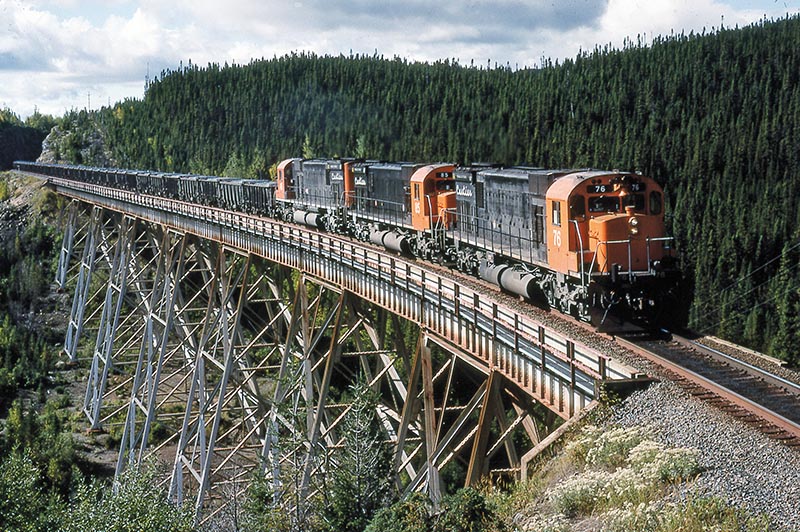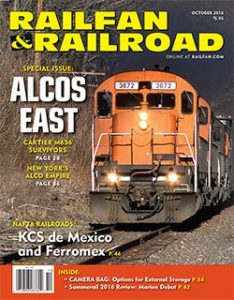 by Jim Rowland/photos as noted
by Jim Rowland/photos as noted
December 5, 2002, dawned cold and clear in the remote northern Quebec town of Port Cartier. Located almost 12 hours northeast of Montreal, it is a place few people go. Ships have regularly called on this St. Lawrence River port since the discovery of iron ore north of Port Cartier and the subsequent parade of Cartier Railway trains ferrying ore to the docks for shipment. While it was a regular day on the St. Lawrence River, the cargo M.V. Aivik was carrying was anything but routine. Inside were eight pieces of heavy industrial machinery — Alco/ MLW six-axle C636/M636 locomotives to be exact.
Since the railroad serving Port Cartier is insular, any equipment destined to or from this line has to be transported by ship. As these locomotives cruised toward their next railhead at Montreal, they were all unlikely survivors that should have long ago succumbed to the scrapper’s torch. Most Alco Centuries had long been consigned to the scrapyard in the late 1970s and early 1980s, especially six-axle units. In 2002, the survival of these diesels was nothing short of a miracle. Like a phoenix, this “Gang of Eight” rose again.
Cartier Railways
In 1957 U.S. Steel formed Québec Cartier Mining Company to construct an iron ore mine in the Quebec-Labrador Trough. The mining company formed the Cartier Railway to haul the ore 190 miles to the processing plant and port at Port Cartier, formerly known as Shelter Bay. On July 5, 1961, when the required infrastructure was finally operational, ore was being loaded into ships. Cartier’s initial power consisted of a fleet of nine EMD GP9s and eight MLW RS18s.
By 1972, after nearly 12 years of uninterrupted mining, the Lac Jeannine mine was facing depletion. Concurrently, the Cartier Railway was planning to extend the line to serve a new mine at Mont Wright, the site of another massive ore deposit 86 miles to the north of Lac Jeannine. In 1973, U.S. Steel awarded Morrison-Knudsen (MK) the contract to build the extension, and when MK began work in 1974, it imported its own locomotives to propel the work trains. These engines numbered 5401–5403 were the former Alco C636 demonstrators that were built in November 1968.
When the 86-mile extension was completed, Cartier required supplemental motive power. Alco locomotives were rostered by various other U.S. Steel railroads, but their degree of operating success varied greatly. With Cartier displaying a solid record of success with Alcos, U.S. Steel transferred six Bessemer & Lake Erie RSD15s (Cartier 91–96) in June 1972, and ten Duluth, Missabe & Iron Range (former Union Pacific) C630s (Cartier 30–39) during 1973 and 1974. Also, Cartier purchased new MLW M636 diesels in January 1972 (Cartier 71– 73) and October 1973 (Cartier 74–76).
The lugging ability, horsepower, and high reliability of MK’s former Alco C636 demonstrators impressed Cartier enough that it purchased the units from MK when the construction was complete in 1974. These engines became Cartier 77–79. In total, these acquisitions were a good start, but the existing and projected traffic required additional power. Cartier returned to MLW for additional M636s in March 1975 (Cartier 81–85). Still power short, it acquired some secondhand Canadian National M636 diesels in 1976 (Cartier 41–49 and 86–87). After these units were off-loaded from their sailing vessels at Port Cartier, the Alco acquisitions were complete.
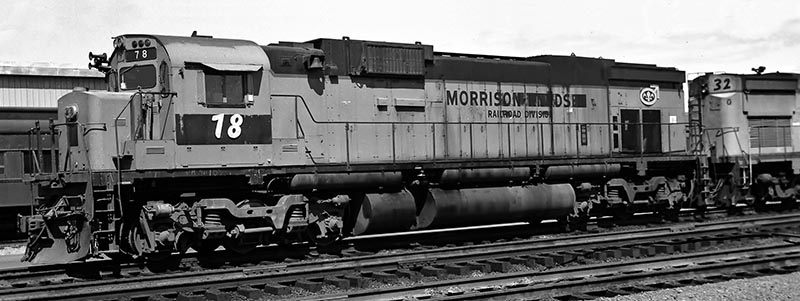
Alco 636-2 became MK 5402, and then QCM 78. Wearing Cartier numbers and corporate insignia, the 78 is seen in the company of a former Union Pacific C630 on August 1, 1975. Neil Shankweiler photo, Mel Wilson collection
Life on the Cartier
The engines, lovingly cared for, were well-maintained by the Port Cartier shop forces, and road failures were the exception rather than the rule. Being an insular operation hundreds of miles from the closest railhead, Cartier had to be self-sufficient, and maintenance practices reflected that. For Cartier, Alco 251 prime movers were highly esteemed and rarely cursed. The degree of skill and precision present in their shop was comparable to what exists at Juniata or Huntington today. It was this level of skill that would keep the fleet going for the next two-and-a-half decades.
In 1999, realizing that its M636s were needing another major overhaul, a decision needed to be made. Initially, thoughts were given to upgrading the M636 fleet. As a test, No. 84 was selected to be the first unit to undergo a thorough rebuild and modernization. It emerged with a new cab, major upgrades to the prime mover and computer system, and a new paint scheme; units 83, 86, and 87 followed.
While successful, the fact remained these were aging units. By 2001, Cartier made the decision to replace the Alcos with new GE AC4400CWs. Originally, a fleet of 12 M636s was going to be thoroughly overhauled and retained for supplemental power. After ordering more GEs, the number of units to be retained was dropped from 12 to eight, including the five units already rebuilt. By mid-2002, the GEs began to arrive and were placed into service, and in early fall the vast majority of Cartier’s Alco/MLW fleet was stored serviceable. Engineers note that the last Alco-powered ore train tied up at 3:30 a.m. on October 16, 2002.
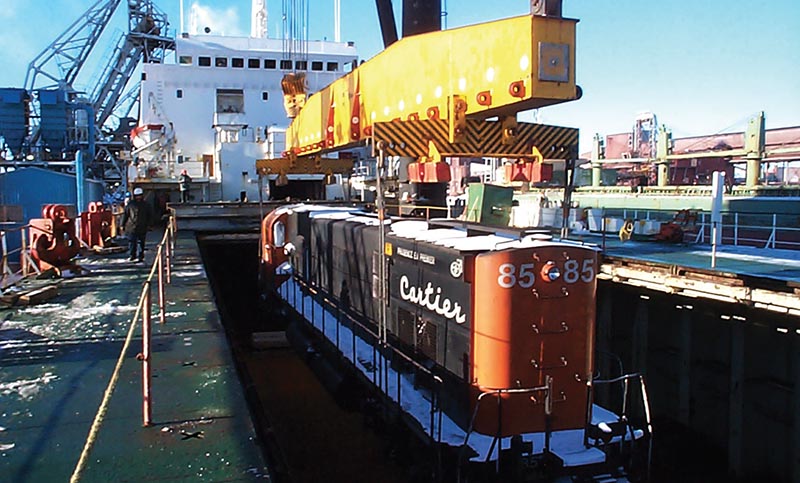
Veteran Cartier engineer Jim Redmond documented the loading of the locomotives onto the M.V. Aivik on December 3 and 5, 2002, at Port Cartier. Each unit was pushed into place, loaded by cranes mounted on the ship, and secured in place on the vessel. Three units were placed on the inside and five were secured on the open deck. The Aivik sailed on December 5 and arrived in Montreal 36 hours later. Jim Redmond photo
Coming to America
While all this was going on in Canada, a new railroad was coming together in the U.S. The former Erie Lackawanna mainline was, for the vast majority west of Hornell, N.Y., left for dead by Conrail. However, local rail officials and county leaders banded together and in 2001 were successful in leasing the entire line from Hornell to Corry, Pa., from then-current owner Norfolk Southern, with the long-term goal of restoring the entire corridor to service. Livonia, Avon, & Lakeville subsidiary Western New York & Pennsylvania began operations on the active portion of the line between Olean and Falconer, N.Y., on April 23, 2001. Repairs began on the outof- service portions of the line, and the group acquired the Corry-to-Meadville section in 2002. By the winter of 2002-03, the Hornell-to-Meadville main was once again open for business.
So what’s the connection between a Canadian railroad changing motive power and a new railroad forming in the States? On the surface, the answer is nothing. However, several individuals involved with regional rail systems and holding a strong belief in Alco power began to talk. The primary individual responsible for the acquisition of the Cartier Alcos was Wes Weis, president of the Morristown & Erie Railroad. “I seem to recall that about late summer 2002, someone on our staff told me the Cartier was getting ready to dispose of its Alcos,” Weis recalled. “I began to talk to other operators in the region, and I approached the WNYP management.” He thought the units would be suitable for their operations, with heavy through coal traffic expected over some significant grades; the Alcos seemed like a good fit. Plus, WNYP was well-versed in Alco locomotives thanks to the railroad’s CMO, Kevin McGarvey.
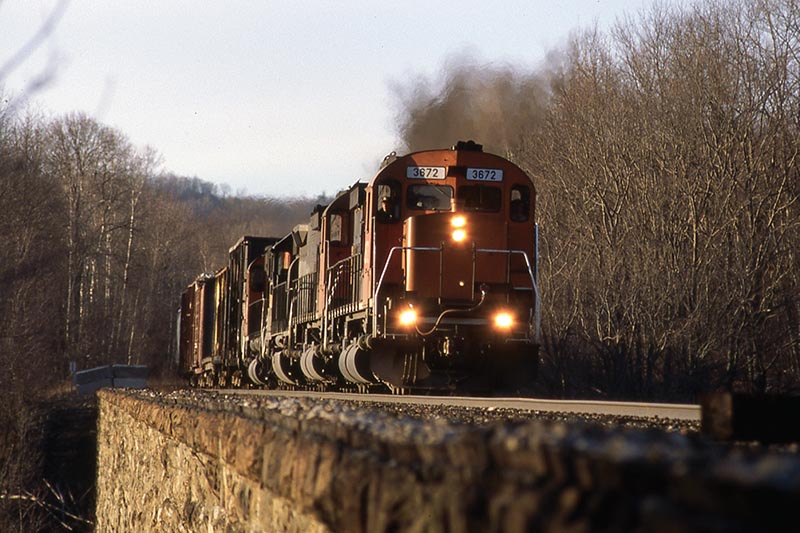
New York, Susquehanna & Western No. 3672 with westbound train SU-99 as it cruises across historic Starrucca Viaduct in Lanesboro, Pa., on April 2, 2006. Jim Rowland photo
Weis and his mechanics made an inspection trip to the Cartier, and were immediately impressed by the condition of the units. “Only one unit, the 85, had a mechanical defect,” he recalled, “it was spitting oil out of its stack.” Weis made an offer on the spot and purchased the entire group of eight units. Some were leased by 636 Leasing (SIXX) and others by Railroad Power Leasing (RRPX), both companies owned by the Weis family.
Boat transportation from Port Cartier to Montreal was arranged, with a handoff to Canadian Pacific and Norfolk Southern for delivery to Binghamton, N.Y. Units 41, 43, 45, 47, 75, 77, 78, and 85 were loaded onto the M.V. Aivik on December 3 and 5, 2002. The ship sailed from Port Cartier to Montreal late in the day on December 5; by the end of the month the entire fleet was parked at the LA&L-subsidiary Bath & Hammondsport shop at Cohocton, N.Y.
Change is always a constant on the railroad, and that was the case with these units. The plans for the six-axles to run on WNYP did not come to fruition, so they slumbered at the Cohocton shop until the call to duty came in 2004…
 Read the rest of this story in the October 2016 issue of Railfan & Railroad
Read the rest of this story in the October 2016 issue of Railfan & Railroad


